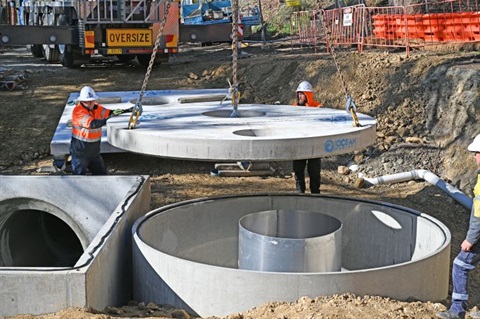
The final piece of a huge underground concrete chamber designed to trap litter before it pollutes the Hobart Rivulet and threaten Hobart's waterways and habitat has been installed below the city's tip face.
A giant concrete lid will be lowered onto an 18-tonne diversion chamber that is buried deep in the ground to massively bolster defences preventing deadly litter such as hair ties and plastics from being washed into the Hobart Rivulet, where they can strangle platypus.
The rivulet is also home to Hobart's largest platypus population.
The $500,000 project is fully funded by the City of Hobart and is a response to a powerful community campaign to better protect the health of the waterway and aquatic ecosystem from litter.
The gross pollutant trap is made up of three cylinders and one diversion chamber, weighing in collectively at just under 45 tonnes, and capable of holding nearly 10 cubic metres of litter, far in excess of the existing downstream "sock" which has a tenth of the capacity.
The new trap is also capable of capturing much smaller litter particles—down to just 1 millimetre in size—as well as sediment and hydrocarbons.
The entire installation is being carried out by the City of Hobart's civil projects team.
Quotes to be attributed to Hobart Lord Mayor Anna Reynolds:
"The installation of this gigantic underground litter trap is a game changer for the health of the Hobart Rivulet, the platypus that live in this waterway and the people that live along it.
"It's the result of strong community voices calling for better protection for our platypus from litter such as hair ties and string, which can be deadly for our platypus.
"It's also the result of the tireless work of Pete Walsh, Hobart's very own platypus guardian who has dedicated every waking hour to highlighting the threats facing our platypus and helping us better understand this mysterious creature.
"The litter trap can capture and store 9.5 cubic metres of rubbish and other pollutants, vastly outstripping the one cubic metre capacity of the old and degrading litter sock.
"The new litter trap will improve water quality by intercepting pollutants from the tip and McRobies Gully stormwater system, reducing the amount of litter and plastic waste ending up in our environment.
"Our platypus and other aquatic wildlife are the big winners from this project, but the community will also benefit from a cleaner and healthier rivulet environment."
Quotes to be attributed to platypus expert Pete Walsh:
"It's incredible to see the City of Hobart prioritise the rivulet in such a tangible way.
"This is a massive piece of infrastructure. It will catch a lot of the litter that in the past has gone directly into the Hobart Rivulet.
"The level of ownership of the Hobart Rivulet, from the local community all the way through to the council, is something we can all be proud of.
"My top tip for caring for our platypus is to 'Seize it, Snip it, Bin it!'. Pick up all circular litter, such as hair bands or rubber bands, snip it and dispose of it correctly."






